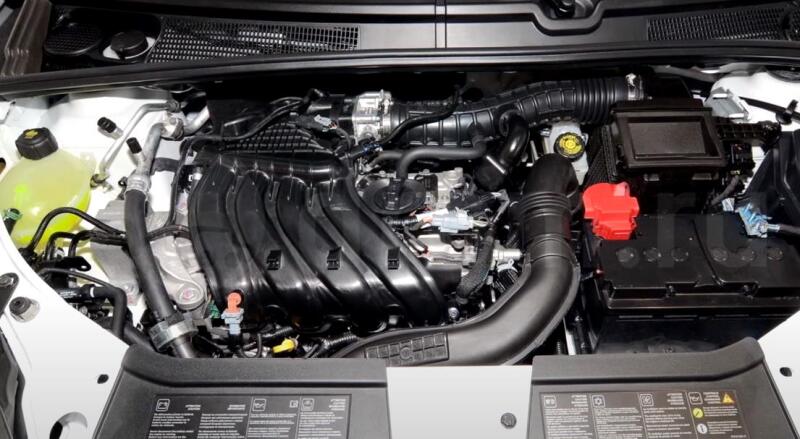However, there are several ways to help find out whether an engine has an oil leak without any tools or instruments. The method, of course, does not give a 100% guarantee, but it still helps. One sign is not a reason for concern. But if there are several of them, you should think carefully before purchasing. Otherwise, you may end up having to overhaul the engine. So what should you pay attention to?
Visual inspection
First, let’s remember the old “old-fashioned” method and take a look at the color of the exhaust. There is nothing new here: the blue color indicates the combustion of not only fuel, but also oil in the cylinders. There is a nuance: if the smoke is blue at startup and then turns white, it also does not bode well. This indicates that while the car was parked, lubricant leaked into the cylinders, which immediately burned out when the engine started. The reason is most likely due to bad valve stem seals. Another sign of their malfunction is a black “ring” on the outside of the exhaust pipe.
 Valve seals and their guides are one of the reasons for oil leaks. Photo: YouTube.com
Valve seals and their guides are one of the reasons for oil leaks. Photo: YouTube.comThe wider it is, the more lubricant the engine “bursts”. By the way, the problem is not always the valve stem seals: the reason may lie in worn guides. And they are more difficult to change than oil seals. In short, there should be no blue exhaust under any circumstances.
You can ask the seller to take a ride and follow him. Blue smoke during gas changes and sudden acceleration will be given off by the oil burner.
If there is an assistant or the seller does not mind, you can carry out the following “operation”. Warm up the engine to operating temperature and increase the crankshaft speed to 3000 per minute for five to ten seconds. Then sharply press the accelerator pedal to the floor and release it just as quickly. A cloud of blue smoke coming out of the muffler is a sign of an oil burner.
 Blue smoke – the CPG is worn out. Photo: YouTube.com
Blue smoke – the CPG is worn out. Photo: YouTube.comAlso inspect the muffler: if it is smoked and/or there is greasy “fluff” inside, it is better to refrain from buying a car. Water may leak out of the pipe - for cars equipped with a catalytic converter, this is generally considered the norm. We've sorted out the exhaust, let's move on.
trunk
What does he have to do with it? It's simple: when a car consumes excessive amounts of oil, the driver will carry a supply. If there is a large canister inside with a small residue of 300 grams, this is normal. Usually they buy lubricant in containers of four or five liters. When replacing everything does not fit into the motor. There’s nowhere else to pour it, but it’s a shame to throw it away. And the habit of the “Soviet” type - you never know, maybe it will come in handy...
 The trunk may be empty, but it's worth a look. Photo: YouTube.com
The trunk may be empty, but it's worth a look. Photo: YouTube.comBut a canister half filled makes you think. Someone will say: a car owner can easily remove everything from the trunk before selling it. Yes, this is possible. But you still need to take a closer look at the floors and upholstery, which may have traces of oil on them.
Under the hood
The first object of inspection is a dipstick for checking the amount of lubricant in the engine. If it is removed frequently, the area around the tube into which it is inserted will be "sludged" with oil. It is possible that traces of it will also be around the neck where it is poured. In fact, there should be no oil drips in principle.
 The area around the dipstick tube must be clean. Photo: YouTube.com
The area around the dipstick tube must be clean. Photo: YouTube.comBut you shouldn’t focus too much, for example, on traces of grease under the valve cover. If the rest of the car is good, replacing the gasket is easy. Technical fluid leaks are not a problem.
Unscrew the neck plug
Nothing bad will happen when the engine is idling: so unscrew it with confidence! If the smell of gasoline hits your nose, then this is bad. This sign indicates that oil is mixed with the fuel. This happens when the piston rings become coked or severely worn (people say “stuck”). The second point is the presence of smoke. If it is barely noticeable, everything is fine, but when it comes out, like from a chimney in a house with a stove, the “oil guzzler” is inevitable. And the reasons are the same as those discussed just above.
 If at idle the unscrewed cover bounces slightly, this is normal (when you lightly press the gas, the shaking stops). Photo: YouTube.com
If at idle the unscrewed cover bounces slightly, this is normal (when you lightly press the gas, the shaking stops). Photo: YouTube.comNext, you should look inside by shining some small flashlight into the neck (you need to stock up on them in advance) or your phone. A coating in the form of a yellowish varnish on the camshaft journals indicates a late oil change or the use of the cheapest grades.
 This is what varnish coating looks like. Photo: YouTube.com
This is what varnish coating looks like. Photo: YouTube.comWell, if you see sludge and dirt there, you should immediately refuse the purchase. When you think everything is fine, run your finger along the inside of the lid. If there is clean oil on it, everything will be fine. The presence of black burning indicates impending problems with the engine.
By the way: if there is a white coating under the cap, it means that coolant is penetrating into the cylinders. But if everything happens in winter, then this may be a normal phenomenon (after a long warm-up, everything will disappear).
Now it’s worth assessing the pressure in the crankcase. Some people say that the cover on a good engine should almost stick when put in place. Well, that's a bit of an exaggeration. This can happen, but not always. But the air flow escaping from the neck may indicate insufficient compression, which in such cases is recommended to be checked. But there is a second reason for this phenomenon - a faulty crankcase ventilation system. The problem can be solved by replacing the corresponding valve (most likely, it is stuck).
 The air filter is usually changed before selling a car. Photo: YouTube.com
The air filter is usually changed before selling a car. Photo: YouTube.comAnother method to check for excessive crankcase pressure is to inspect the air filter. But disappointment may await you here: in most cases, the car owner changes this element before selling it. And if you are “lucky”, then a coating of lubricant on the “consumable” indicates wear of the parts of the cylinder-piston group or high pressure in the crankcase.
Candles
Of course, not everyone wants to tinker with them: unscrew them, then put them back in. And some people don’t know how to do it. But if there is an opportunity to look at candles, it would be a sin not to take advantage of it! Black carbon deposits with traces of grease on the threads are 100% oily. It is not for nothing that this diagnostic method is considered very accurate. True, there is a “catch” here. On some engines, removing the spark plugs is a real problem!
 Unscrewing spark plugs from such engines is quite inconvenient. Photo: YouTube.com
Unscrewing spark plugs from such engines is quite inconvenient. Photo: YouTube.comAn example is the power unit on a Nissan or Renault under the symbol HR16DE (on French cars - H4M). And cars with such an engine cannot be called premium and the oil burner is not noticed behind them, but in order to remove the spark plugs, you will have to dismantle the intake manifold.
Verification of documents
Well, depending on your luck... The best option is to purchase a report that shows the machine's maintenance history. Sometimes it is possible to find a record of the engine decarbonization procedure. This can be considered a great success: most often such an operation is done independently or in small car services, where there is often no document flow. If there is such a record, then, most likely, using this procedure they wanted to get rid of the neglected oil burner. And when this does not lead to the desired results, the car is put up for sale. By the way: an inexperienced seller can even “boast” about such a record - this is how I take care of my car. But you shouldn’t fall for such “tricks”, and it’s better to refrain from purchasing.
Conclusions
Of course, if the seller is an experienced car owner with experience (or has read similar articles!), it will be more difficult to determine that the car is “bursting” oil. Still, it's worth a try: your time spent could translate into money saved or a better purchase.










